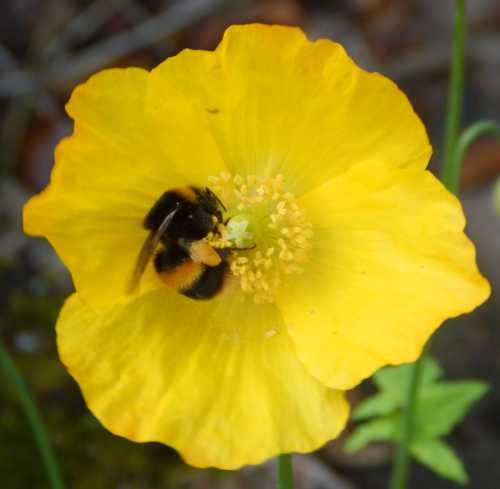Bombus lucorum –
The White-tailed Bumble Bee
Updated: 29th February 2024
Bombus lucorum, the white-tailed bumblebee, is one of the more common species of bumble bee found in Britain, and one of the most widespread.
New queens are among the first bumble bee species to emerge following their winter snooze, and so this is a species I anxiously
look out for in the early spring.
Identifying Bombus lucorum
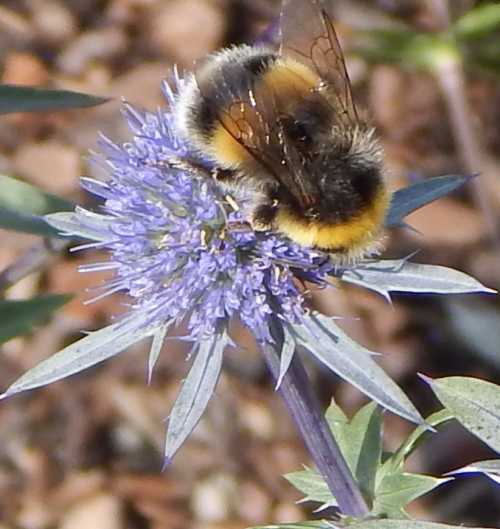 White-tailed bumble bee on Eryngium.
White-tailed bumble bee on Eryngium.Queens are large (18 – 22 mm) although usually a little
smaller than the buff-tailed bumble bee, Bombus terrestris.
Bombus lucorum can sometimes be confused with Bombus
terrestris at first glance. The latter usually
has a cream/off-white tinge to the tail, and whilst workers can have white
tails, there will often be a very faint yellow band where it meets the black
segment on the abdomen.
Worker white-tailed bumble bees often have additional fine yellow bands on the thorax and abdomen, and males have yellow hairs on the face.
There are a number of variations seen within sub-species: Bombus magnus (northern white-tailed bumble bee) and Bombus cryptarum (cryptic bumble bee), such that distinguishing between B. terrestris may be even more difficult due to the white tails sometimes appearing to be tinged brown or yellowish in colour1.
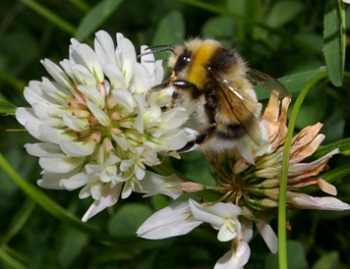 White-tailed bumble bee - Bombus lucorum - male.
White-tailed bumble bee - Bombus lucorum - male.Bombus lucorum Lifecycle And Nesting
Queens may emerge as early as February, and once they have replenished their food reserves by foraging on flowers such as crocus, winter heathers, mahonia, white and red dead nettles, prunus, flowering currant and (later) bluebells, you may see them flying close to the ground, investigating holes, crevices, dips and grassy tussocks, as they seek a suitable place to nest.
Mouseholes and other abandoned underground nests of small mammals, are favoured.
Once queens are seen with pollen loads on their hindlegs (in the corbicula) then this can be taken as a signal that the queen has already established a nest.
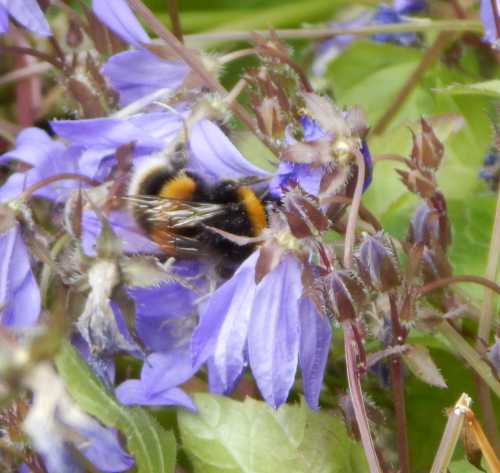 White-tailed bumble bee - Bombus lucorum on Campanula flowers.
White-tailed bumble bee - Bombus lucorum on Campanula flowers.Workers may appear from late March to middle of May, depending on
location and conditions. Some colonies produce males early in the season, some
later, but males and daughter queens may be seen from late May to June onwards.
Colonies can reach as many as 400 workers. Second broods may be produced in the southern parts of Britain, depending on weather conditions, meaning this species may be seen as late as October in some areas.
However, in some years, they have even been seen through winter, foraging in parks and gardens in southern England.
Foraging Preferences
In addition to the plants mentioned above, Bombus
lucorum forage on a wide range or flowers, shrubs and trees, including:
Garden shrubs and herbs: Ceanothus, Buddleia, hebe, jasmine, privet, lavender, Hypericum, honeysuckle and many more.
Garden flowers and herbs: wall flower, Campanula, sage, lupins, sedum, sunflowers, cosmos, coneflower, oregano, chives and a wide variety of other plants.
Wild flowers and shrubs: bramble, red bartsia, clovers, knapweed, thistles, viper’s bugloss, vetches and trefoils, comfrey among others.
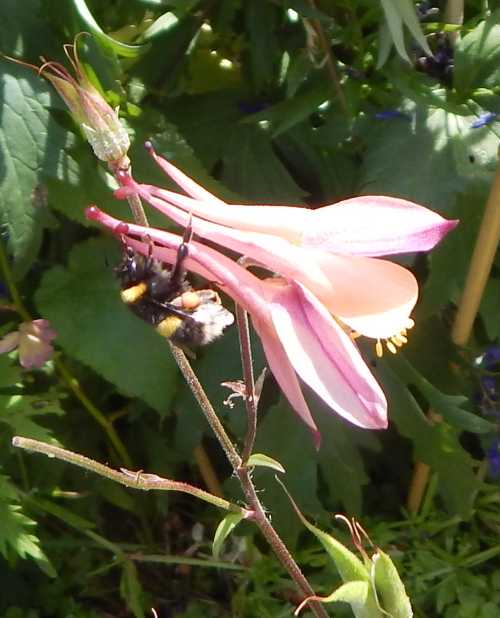 Nectar robbing Acquilegia flower
Nectar robbing Acquilegia flowerAll bumble bee species are categorized as 'long-tongued', however, Bombus lucorum have shorter tongues than some other bumble bee species, and can sometimes be caught nectar robbing.
Reference
1. Bertsch, Andreas & Schweer, Horst & Titze, Andreas. (2004). Discrimination of the bumblebee species Bombus lucorum, B. cryptarum and B. magnus by morphological characters and male labial gland secretions (Hymenoptera: Apidae). Beiträge zur Entomologie. 54. 365-386. 10.21248/contrib.entomol.54.2.365-386.
Read more about bumble bees
- Is It Bumble Bee Or Bumblebee? Is It Written As One Word Or Two? Although both are used widely, here's an explanation as to why, according to the Entomological Society of America, it should be written as two words.
- The Bumble Bee Life Cycle - A Description, Photos And Video The bumble bee life cycle starts with an impregnated queen when she emerges from her nest from her winter snooze. She feeds and seeks a suitable place to nest.
- Bumble Bee Nests: Nesting Preferences Of Different Bumble Bees, and challenges in finding suitable locations for nesting.
- Bumble Bees All about bumble bees - their life cycles, pollination, and answers to common questions.
- Do Bumble Bees Make Honey? Bumble bees store nectar in little wax pots for feeding the colony as it grows, but it is not really quite the same thing as honey made by honey bees.
If you found this page helpful or interesting, I'd really be grateful if you would share it with others - if not this page, perhaps another, such as Gardening For Bees.
Thank you so much :) .
